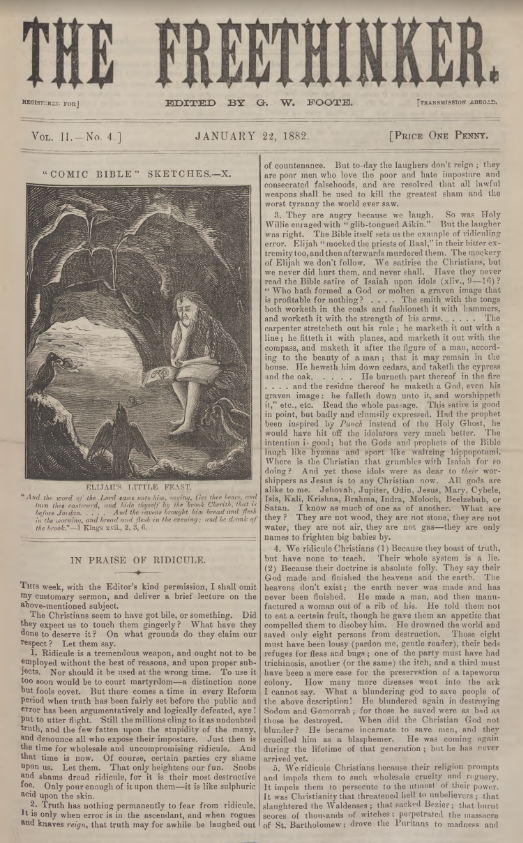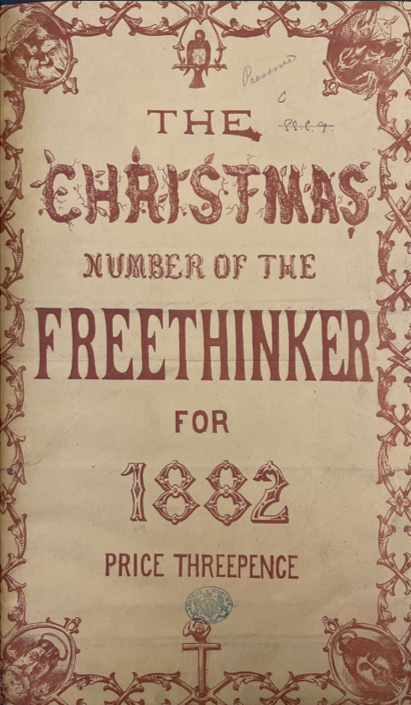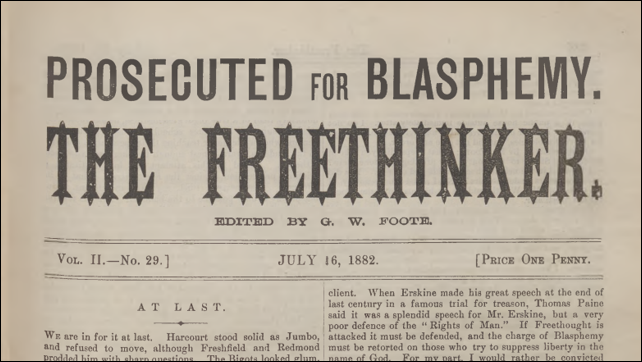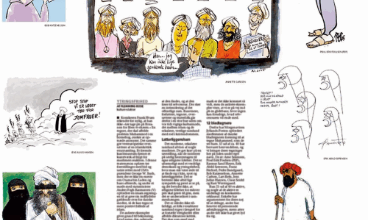
In an early Freethinker editorial, George W. Foote commented that ‘The public now-a-days is in a great hurry, you must attract its attention before you can be heard.’ While some Victorian atheists, agnostics, and secularists sought to attract attention and further their cause by publicly debating with prominent religious figures, standing for Parliament, and emphasising the respectability of their secular ideology, Foote actively courted outrage. This article explores how through the Freethinker he tested the old adage that all publicity is good publicity, and got the press and public talking about these working-class radicals who challenged the religious and political establishment in order to bring about a more equal society.
Freethinkers were mostly republicans, sometimes socialists, and campaigned for the removal of religion from public life alongside causes such as women’s rights, workers’ rights, secular education, and birth control. They occupied a marginal position in Victorian Britain. Membership of the National Secular Society peaked at just a few thousand, while sales of even the most successful weekly journals arising from the movement – the National Reformer and the Freethinker – rarely exceeded 10,000. However, due to the dangers that many believed atheism posed to society, and to the legal cases involving Charles Bradlaugh, Annie Besant and Foote himself, the words and actions of this minority group came to occupy a significant position within the public consciousness.
The weekly Freethinker was established in 1881 as a proactively ‘anti-Christian organ’. Foote’s editorial in the first issue emphasised that its approach ‘must therefore be chiefly aggressive. It will wage relentless war against Superstition … and it will not scruple to employ for the same purpose any weapons of ridicule or sarcasm that may be borrowed from the armoury of common sense’. This provocative strategy amplified minority voices such as Foote’s in the public sphere, enabling freethinkers to play an outsize role in shaping British perceptions of religion as under attack in the second half of the nineteenth century.
In 1882 and 1883 blasphemy charges were levelled at the Freethinker. These legal challenges focused on the ‘Comic Bible’ cartoons that appeared on the front page across the 1880s and the 1882 Christmas number, which because of the subsequent trial became infamous for its irreverent ‘A New Life of Christ’, satirical cartoons, and profane jokes. The historian David Nash describes Foote’s publication of this content as ‘calculated to inflame public opinion’ and ‘activate the creaking and unwieldy machinery of the blasphemy laws’ so that he would be granted a legal platform from which to challenge the powers that be. Foote revelled in being, in his words, ‘on the Devil’s side’, but emphasised that despite charges from opponents that the publication was ‘“foul and filthy” … No filth ever appears in our pages except what is derived from the Bible’. Lord Coleridge ruled in Foote’s trial that ‘if the decencies of controversy are observed, even the fundamentals of religion may be attacked without a person being guilty of blasphemous libel’. The court cases therefore pivoted on the manner in which the Freethinker attacked religion, and the fact that Foote had made such ideas accessible to a working-class audience.

An Observer editorial in 1883 painted this strategy as doomed to fail: ‘we venture to think that Mr. Foote will get very little sympathy from the general public, and as little, or less, from advanced thinkers, who, being men of education, have not cared to state their views in an offensive shape’. In comparison to the sincere beliefs of Quakers, Jews, and Unitarians (the editorial continued), ‘an Atheist of the proselytising school can only make his living by throwing mud; and it becomes a public duty to teach him that throwing mud is a public nuisance, and is not to be tolerated.’ Characterising the Freethinker’s content as trivial and insincere, the editorial rejects the idea that freethought was a legitimate world view on a par with dissenting Christian denominations and Judaism. However, in conflating these two things, the editorial overlooked the point that irreverence can arise from sincerely held beliefs; it therefore misunderstands the Freethinker’s rationale.
The Freethinker was explicit in its aim to ridicule religion and potentially cause offence. Joseph Symes’s front-page article ‘In Praise of Ridicule’ characterised this approach as an inevitable and necessary response to the society in which they lived: ‘there comes a time in every Reform period when truth has been fairly set before the public and error has been argumentatively and logically defeated … Still the millions cling to it as undoubted truth, and the few fatten upon the stupidity of the many, and denounce all who expose their imposture. Just then is the time for wholesale and uncompromising ridicule. And that time is now.’ Symes therefore emphasised the seriousness with which the Freethinker wielded its irreverence and concluded, ‘We don’t play with satire, we fight with it.’
Throughout the 1880s – before, during, and after the legal challenges – regular columns were titled ‘Profane Jokes’, ‘Comic Bible Sketches’, ‘Rib Ticklers’, and ‘Acid Drops’, the latter highlighting bad and hypocritical behaviour from religious people and institutions. The irreligious humour spills out of such columns and pervades other elements of the journal that usually served more prosaic functions too. ‘To Correspondents’ columns were usually a practical way to engage with reader letters, but in the Christmas 1882 issue Foote repurposed them for heretical comic effect: the ‘Holy Ghost’ is advised that he will need to pay child support if proven to be the father of Jesus.

Foote’s desire to capitalise upon his notoriety is clear. From 16 July 1882 until 24 February 1884 (the last issue before his release from Holloway prison), ‘Prosecuted for Blasphemy’ was trumpeted at the top of the front page of every issue of the Freethinker, in font almost as large as the journal’s title. From 18 March 1883, the details of the sentences for editor, printer and proprietor were added to the masthead. But was the publicity generated by the court cases successful in raising the journal’s profile in a way that benefited Foote and other freethinkers?
Foote’s ‘New Year’ column in 1883 celebrated the fact that the Freethinker had doubled its circulation over the preceding year. In a later issue, a correspondent identified as ‘Anxious’ is reassured that the magazine is responding to surges in interest: ‘We printed thousands of extra copies of the Freethinker last week, but not nearly enough for the enormous demand’. The publicity therefore increased circulation, as both the curious and the sympathetic sought out the publication to judge for themselves.
But the publicity also had a more intangible impact. As Foote observed in 1883, ‘The Freethinker is now an institution’. After less than two years of publication, the furore surrounding the Freethinker had given it a sense of legitimacy, purpose, and even permanence, despite the justice system’s best attempts to undermine it. In the same column, Foote also praised ‘the many friends who have helped to give the Freethinker publicity in various ways’. This comment had two quite different meanings.
The first is that, after newsagents and wholesalers became intimidated by the legal challenges, readers responded with gusto to Foote’s call for friends of the Freethinker ‘to push the paper as far as they possibly can’. This led to increased subscriptions, for example ‘An Atheist Blacksmith’ vowed that he and his friends would double their subscription in the event of Foote’s conviction; this was escalated the following week, when another reader promised to take six copies per week. Alternative modes of circulation among acquaintances and social clubs are also documented, while a Scottish bookseller wrote in to say that he was going to buy in copies and post the contents on his shop door. Although we cannot be certain that all reader contributions are genuine, these letters nonetheless praised and therefore encouraged specific reader behaviours that would bring the Freethinker to a wider audience.
Foote’s comment about ‘the many friends who have helped to give the Freethinker publicity in various ways’ can, however, be interpreted as being partly tongue-in-cheek as well. The regular column ‘Sugar Plums’ recorded the gains made by the freethought movement and often excerpted newspaper coverage, which, even when not positive, provided free nationwide publicity. As Foote comments knowingly, ‘The press is beginning to find out that there is a large public interested in Freethought’. This impact was acknowledged by other newspapers, as the Freethinker gleefully recounts: ‘The London Echo points out one of the consolations (to us) of our second prosecution: “If people in future everywhere do not know something of the Freethinker it will not be for want of advertising it in the House of Commons and the law courts.”’ The Echo compared the situation to the way in which sales of The Fruits of Philosophy were boosted during the proceedings against Bradlaugh and Besant in 1877, observing that having been provided with ‘gratuitous national advertisement’, the Freethinker ‘will be more sought after and read than before’.

Foote’s sentencing stimulated further anxieties among the mainstream press. The Spectator was concerned that twelve months’ imprisonment was an attack specifically on working-class freedom of speech, which reflected badly upon British society and might render Foote a martyr: ‘considering the extreme severity of the punishment inflicted for publishing what no one was compelled either to see or read … no one will be able to avoid comparing what Mr. Foote has done, with what more refined assailants of the Christian faith have done without the smallest risk of prosecution’. While Foote was not glorified in the popular press, this concern for the prosecution’s wider implications indicates how publicity had the potential to soften attitudes to the freethought cause.
Within the movement, the reaction to Foote’s combative approach was mixed. While some Victorians were brought into the freethought fold, many of Foote’s fellow freethinkers disagreed with his tactics, advocating instead for moderation and more good faith engagement with their religious contemporaries. Foote was editor from 1881 all the way until his death in 1915. However, the provocative front-page cartoons were dropped in 1889, and the tone of the Freethinker changed quite markedly from 1891 when Foote became president of the National Secular Society upon Bradlaugh’s death. The Freethinker consequently took over from the National Reformer as the principal mouthpiece of the movement, expanding its remit to documenting secularist activities more broadly. However, columns of ‘Profane Jokes’ remained, and Foote continued to pride himself upon publishing a paper that vehemently, and irreverently, challenged religion and its hypocrisies.
Unlike the majority of Victorian freethought journals, the Freethinker remains in publication. The only other UK publication in a non-religious tradition that remains from that era is the New Humanist. While there are many factors that contributed to the longevity of the Freethinker, it is tempting to suggest that its rapid rise to prominence through the courting of notoriety stood it in good stead, giving freethinking voices and actions a heightened public platform from which to direct others towards the freethought cause. Foote knew the strategy would be divisive, but that it nonetheless appealed to a certain minority. As he reflected in 1915, ‘We were not writing to please purchasers but to inspire evangelists.’








2 comments
Well I have hunted high and low and cannot find any scanned copies of early numbers of The Freethinker. I particularly want to see the Christmas 1882 number, and as this article contains scans from it, hard copies of it evidently still exist.
Please provide links if they are already online somewhere. If not, please consider scanning them and uploading them so all the world can read and enjoy!
Hi Wanda,
Thanks for your comment. We are currently in the process of digitising the whole historical Freethinker from 1881 to its move online in 2014. We’ll be giving further information in due course. Sign up to our newsletter or follow us on Twitter for further updates.
Your email address will not be published. Comments are subject to our Community Guidelines. Required fields are marked *
Donate